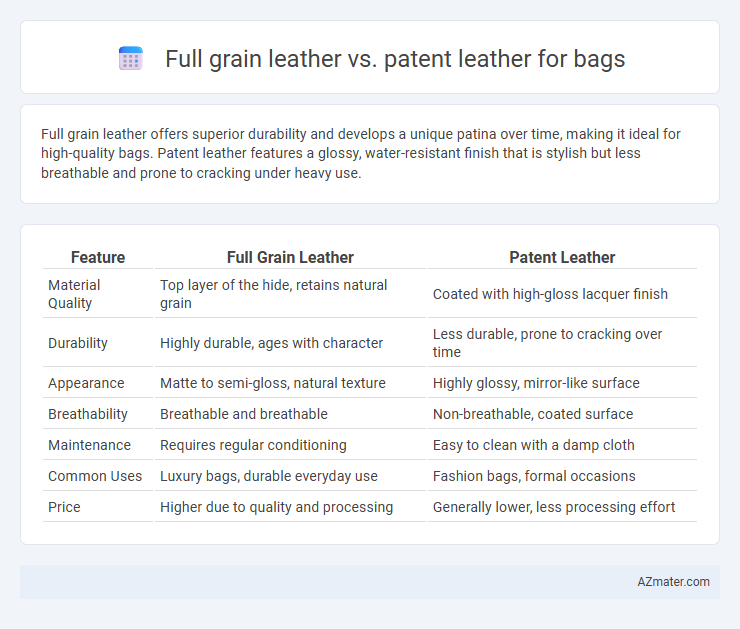Full grain leather offers superior durability and develops a unique patina over time, making it ideal for high-quality bags. Patent leather features a glossy, water-resistant finish that is stylish but less breathable and prone to cracking under heavy use.
Table of Comparison
| Feature | Full Grain Leather | Patent Leather |
|---|---|---|
| Material Quality | Top layer of the hide, retains natural grain | Coated with high-gloss lacquer finish |
| Durability | Highly durable, ages with character | Less durable, prone to cracking over time |
| Appearance | Matte to semi-gloss, natural texture | Highly glossy, mirror-like surface |
| Breathability | Breathable and breathable | Non-breathable, coated surface |
| Maintenance | Requires regular conditioning | Easy to clean with a damp cloth |
| Common Uses | Luxury bags, durable everyday use | Fashion bags, formal occasions |
| Price | Higher due to quality and processing | Generally lower, less processing effort |
Understanding Full Grain Leather: Definition and Characteristics
Full grain leather, derived from the top layer of animal hide, retains the natural grain and imperfections, offering durability and breathability unmatched by other types of leather. This material develops a rich patina over time, enhancing the bag's aesthetic appeal while maintaining resistance to moisture and wear. Unlike patent leather, which features a glossy, coated finish, full grain leather emphasizes natural texture and long-lasting strength.
What is Patent Leather? Unique Features and Appeal
Patent leather is a type of coated leather known for its high-gloss, mirror-like finish achieved through a varnish or lacquer coating. Its unique features include water resistance, smooth texture, and vibrant sheen, making it a popular choice for fashion-forward bags that require a polished, sophisticated look. The appeal of patent leather lies in its ability to combine durability with striking visual impact, enhancing any bag with a luxurious and contemporary elegance.
Durability: Full Grain Leather vs Patent Leather
Full grain leather is renowned for its exceptional durability due to its natural, unaltered surface that develops a rich patina over time, enhancing both strength and appearance. Patent leather, coated with a glossy finish, is more resistant to moisture and stains but is prone to cracking and peeling with prolonged use. For long-lasting bags, full grain leather offers superior wear resistance and longevity compared to the delicate, high-shine surface of patent leather.
Maintenance and Care Requirements
Full grain leather requires regular conditioning and cleaning with specialized leather care products to maintain its durability and natural patina, while avoiding excessive moisture and direct sunlight prevents cracking and fading. Patent leather demands gentle wiping with a damp cloth and occasional use of a patent leather cleaner to preserve its glossy finish, and it is more susceptible to scuffs and discoloration from heat or harsh chemicals. Proper storage in dust bags and away from sharp objects is essential for both materials to extend the lifespan of bags crafted from these leathers.
Appearance: Natural Texture vs Glossy Finish
Full grain leather showcases a rich, natural texture with unique markings and a matte finish that highlights its organic origin, appealing to those who appreciate authenticity and durability in bags. Patent leather features a high-gloss, reflective surface achieved through a coating process, offering a sleek and polished look that stands out in formal or fashion-forward styles. The choice between full grain and patent leather significantly influences a bag's aesthetic, where natural ruggedness contrasts with shiny sophistication.
Water Resistance and Stain Protection
Full grain leather offers moderate water resistance due to its natural fiber structure but requires regular conditioning to maintain durability and protect against stains. Patent leather features a high-gloss, polyurethane coating that provides superior water resistance and excellent stain protection, making it easier to clean and maintain in wet or dirty environments. Choosing patent leather ensures enhanced moisture barrier properties, while full grain leather delivers breathability and long-term aging benefits with proper care.
Aging and Patina Development
Full grain leather develops a rich patina over time, with natural oils and sunlight enhancing its texture and color, resulting in a unique, personalized appearance. Patent leather, coated with a glossy synthetic finish, resists aging and patina formation, maintaining a shiny, uniform surface but lacking the distinctive character gained through wear. For bags, full grain leather appeals to those seeking durability and evolving aesthetics, while patent leather suits those preferring a consistent, low-maintenance shine.
Eco-Friendliness and Sustainability
Full-grain leather is considered more eco-friendly and sustainable than patent leather due to its minimal processing and longer durability, which reduces waste and resource consumption. Patent leather undergoes heavy chemical treatments and coatings that release pollutants and hinder biodegradability, negatively impacting environmental sustainability. Choosing full-grain leather bags supports reduced carbon footprints and promotes natural material longevity.
Price Comparison: Investment Value
Full grain leather bags typically command higher prices due to their durability, natural texture, and aging potential, representing a long-term investment that gains character over time. Patent leather bags, while often more affordable, offer a glossy finish that may wear or crack with time, potentially lowering their resale value. Choosing full grain leather enhances both craftsmanship appreciation and lifetime value, making it a preferable choice for investment-conscious buyers.
Best Uses: Choosing the Right Leather for Your Bag
Full grain leather is ideal for high-end bags requiring durability and a natural, luxurious finish that develops a unique patina over time, making it perfect for everyday use and investment pieces. Patent leather, with its glossy, water-resistant surface, is best suited for formal occasions and fashion-forward designs that need a sleek, eye-catching appearance. Selecting full grain leather ensures longevity and character, while patent leather offers style and easy maintenance for special events.

Infographic: Full grain leather vs Patent leather for Bag
 azmater.com
azmater.com